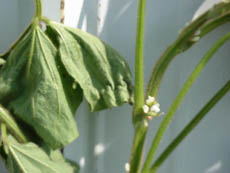|
Since
June 20, many areas of Logan County have experienced rainfalls in
excess of nine inches. Some areas received over nine inches in the
single rain event of June 20 and June 21. Logan County has gone from
the very dry side of normal to the excess side in just a few
rainfalls. Due to the excess, some areas of the county have been
gone downhill rapidly while others have improved dramatically.
 Low
areas, particularly in the section of the county from Beason on
south, have taken the brunt of the moisture damage due to ponding
(where water stands in fields) and debris that has washed out of
fields and ditches. The Atlanta area in general has received less
rainfall and has benefited greatly from the moisture that has come
our way. Low
areas, particularly in the section of the county from Beason on
south, have taken the brunt of the moisture damage due to ponding
(where water stands in fields) and debris that has washed out of
fields and ditches. The Atlanta area in general has received less
rainfall and has benefited greatly from the moisture that has come
our way.

According
to the Illinois Crop Reporting Service, Illinois corn in the Central
Illinois District (including Logan County) was rated as one percent
very poor, three percent poor, 10 percent fair, 51 percent good and
35 percent excellent. Soybeans were rated as one percent very poor,
five percent poor, 21 percent fair, 50 percent good and 23 percent
excellent. Local crop conditions would closely mirror these
averages. The very poor and poor ratings have been drowned out,
covered up or cut off (by hail or blowing silt early on). Then the
ratings just go up from there.

(To
top of second column)
|

It
is important for everyone to remember that these crop conditions are
reflections of what is seen now, but may have little in common with
what things look like at harvest time. Corn in the Central District
was reported as 11 percent silked as of July 2, and we had 36
percent of our soybeans blooming. Due to the early planting season
in Logan County, the local figures would be placed above those for
both crops, with 25 percent silked and 65 percent blooming. A simple
drive around the state, the Midwest or anywhere else will show that
Central Illinois and Logan County crops are among the best looking
anywhere.
Most
area corn is in the early silk to early pollinated stage, while most
area soybean fields are in the bloom to early pod formation stages.
Early potential (and potential is stressed here) kernel counts on
corn ears look to be normal to above normal, with 16 rows of kernels
on average. The number of kernels in each row is what gets to be a
guessing game. The average of ears from a small sample was 48, but
many on the tips of ears will undoubtedly be unpollinated or
aborted.

Most
of Logan County producers will be looking forward to continued
rainfall in more "reasonable" amounts and temperatures in
the moderated range. If all that falls into place, chances are we’ll
have a better than average corn and soybean crop.
[John
Fulton]
|

